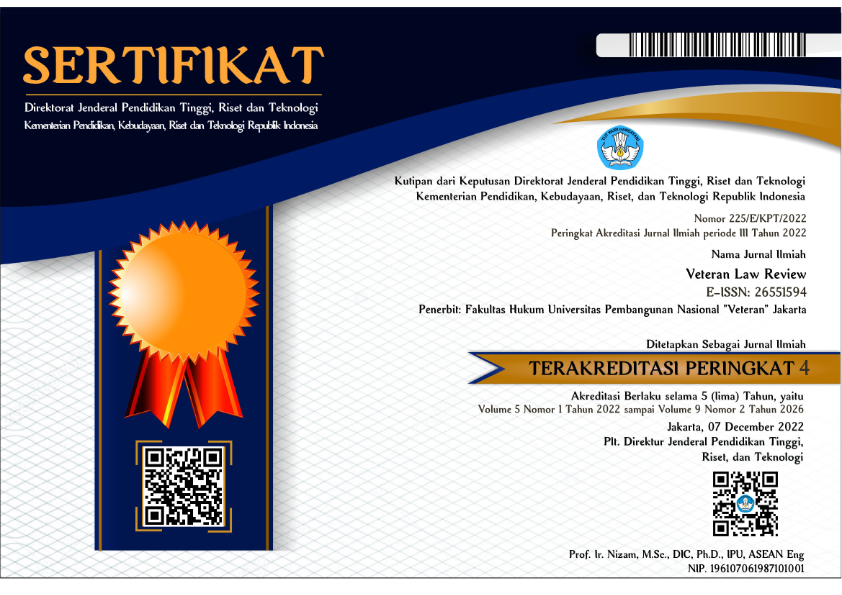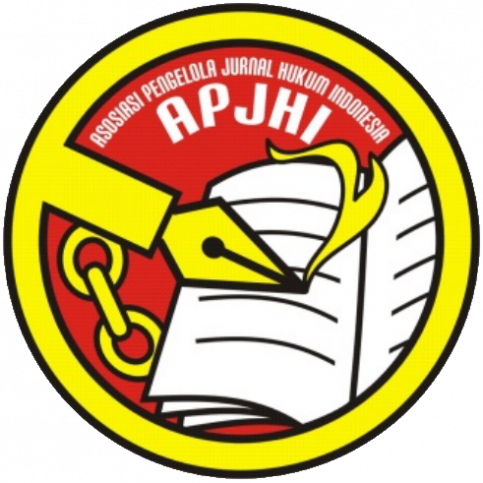About the Journal
Veteran Law Review (VELREV) is SINTA 4 journal published by Faculty of Law, UPN "Veteran" Jakarta. VELREV published biannually in May and November. This journal provides immediate open access to its content on the principle that making research freely available to the public supports a greater global exchange of knowledge.
The aims of this journal as platform or forum for academicians, researchers, and practitioners to publishing the original research articles or review articles. The scope of the articles published in this journal deals with a broad range of topics in the fields of Criminal Law, Civil Law, International Law, Constitutional Law, Administrative Law, Islamic Law, Economic Law, Medical Law, Customary Law, Environmental Law and another section related contemporary issues to law.
ISSN : 2655-1594 | e-ISSN : 2655-1608
Published by: Faculty of Law, Universitas Pembangunan Nasional "Veteran" Jakarta
Focus and Scope
The aims of this journal is to provide a venue for lecturers, researchers, and practitioners for publishing the original research articles. The scope of the articles published in this journal deals with a broad range of topics in the fields of:
- Criminal Law,
- Civil Law,
- International Law,
- Constitutional Law,
- Administrative Law,
- Islamic Law,
- Economic Law,
- Medical Law, Adat Law,
- Environmental Law and
- another section related contemporary issues in law.
Publication Ethics
Veteran Law Review (Veteran Law Rev. - VELREV) is a peer-reviewed journal published by Faculty of Law Pembangunan Nasional Veteran University. This journal is available in online and highly respects the publication ethic and avoids any type of plagiarism. This statement explains the ethical behavior of all parties involved in the act of publishing an article in this journal, including the author, the editor in chief, the editorial board, the peer-reviewers and the publisher (Faculty of Law Pembangunan Nasional Veteran University). This statement is based on COPE’s Best Practice Guidelines for Journal Editors.
Ethical Guideline for Journal Publication. The publication of an article in a peer-reviewed journal of VELREV is an essential building block in the development of a coherent and respected network of knowledge. It is a direct reflection of the quality of the work of the authors and the institutions that support them. Peer-reviewed articles support and embody the scientific method. It is therefore important to agree upon standards of expected ethical behavior for all parties involved in the act of publishing: the author, the journal editor, the peer reviewer, the publisher and the society.
Faculty of Law Pembangunan Nasional Veteran University as publisher of VELREV takes its duties of guardianship over all stages of publishing seriously and we recognize our ethical behavior and other responsibilities. We are committed to ensuring that advertising, reprint or other commercial revenue has no impact or influence on editorial decisions. In addition, the Faculty of Law Pembangunan Nasional Veteran University and Editorial Board will assist in communications with other journals and/or publishers where this is useful and necessary.
Publication decisions. The editor of the Veteran Law Review is responsible for deciding which of the articles submitted to the journal should be published. The validation of the work in question and its importance to researchers and readers must always drive such decisions. The editors may be guided by the policies of the journal's editorial board and constrained by such legal requirements as shall then be in force regarding libel, copyright infringement and plagiarism. The editors may confer with other editors or reviewers in making this decision.
Fair play. The editor at any time evaluate manuscripts for their intellectual content without regard to race, gender, sexual orientation, religious belief, ethnic origin, citizenship, or political philosophy of the authors.
Confidentiality. The editor and any editorial staff must not disclose any information about a submitted manuscript to anyone other than the corresponding author, reviewers, potential reviewers, other editorial advisers, and the publisher, as appropriate.
Disclosure and conflicts of interest. Unpublished materials disclosed in a submitted manuscript must not be used in an editor's own research without the express written consent of the author.
Duties of Reviewers
Contribution to Editorial Decisions. Peer review assists the editor in making editorial decisions and through the editorial communications with the author may also assist the author in improving the paper.
Promptness. Any selected referee who feels unqualified to review the research reported in a manuscript or knows that its prompt review will be impossible should notify the editor and excuse himself from the review process.
Confidentiality. Any manuscripts received for review must be treated as confidential documents. They must not be shown to or discussed with others except as authorized by the editor.
Standards of Objectivity. Reviews should be conducted objectively. Personal criticism of the author is inappropriate. Referees should express their views clearly with supporting arguments.
Acknowledgement of Sources. Reviewers should identify relevant published work that has not been cited by the authors. Any statement that an observation, derivation, or argument had been previously reported should be accompanied by the relevant citation. A reviewer should also call to the editor's attention any substantial similarity or overlap between the manuscript under consideration and any other published paper of which they have personal knowledge.
Disclosure and Conflict of Interest. Privileged information or ideas obtained through peer review must be kept confidential and not used for personal advantage. Reviewers should not consider manuscripts in which they have conflicts of interest resulting from competitive, collaborative, or other relationships or connections with any of the authors, companies, or institutions connected to the papers.
Duties of Authors
Reporting standards. Authors of reports of original research should present an accurate account of the work performed as well as an objective discussion of its significance. Underlying data should be represented accurately in the paper. A paper should contain sufficient detail and references to permit others to replicate the work. Fraudulent or knowingly inaccurate statements constitute unethical behaviour and are unacceptable.
Data Access and Retention. Authors are asked to provide the raw data in connection with a paper for editorial review, and should be prepared to provide public access to such data (consistent with the ALPSP-STM Statement on Data and Databases), if practicable, and should in any event be prepared to retain such data for a reasonable time after publication.
Originality and Plagiarism. The authors should ensure that they have written entirely original works, and if the authors have used the work and/or words of others that this has been appropriately cited or quoted.
Multiple, Redundant or Concurrent Publication. An author should not in general publish manuscripts describing essentially the same research in more than one journal or primary publication. Submitting the same manuscript to more than one journal concurrently constitutes unethical publishing behaviour and is unacceptable.
Acknowledgement of Sources. Proper acknowledgment of the work of others must always be given. Authors should cite publications that have been influential in determining the nature of the reported work.
Authorship of the Paper. Authorship should be limited to those who have made a significant contribution to the conception, design, execution, or interpretation of the reported study. All those who have made significant contributions should be listed as co-authors. Where there are others who have participated in certain substantive aspects of the research project, they should be acknowledged or listed as contributors. The corresponding author should ensure that all appropriate co-authors and no inappropriate co-authors are included on the paper, and that all co-authors have seen and approved the final version of the paper and have agreed to its submission for publication.
Disclosure and Conflicts of Interest. All authors should disclose in their manuscript any financial or other substantive conflict of interest that might be construed to influence the results or interpretation of their manuscript. All sources of financial support for the project should be disclosed.
Fundamental errors in published works. When an author discovers a significant error or inaccuracy in his/her own published work, it is the author’s obligation to promptly notify the journal editor or publisher and cooperate with the editor to retract or correct the paper.
=====================
Anni Alvionita Simanjuntak, S.Pd., MA.
Editor-in-Chief,
Veteran Law Review
Peer Review Process
Every article that goes to the editorial staff will be selected through Initial Review processes by Editorial Board. Then, the articles will be sent to the Mitra Bestari/peer reviewer and will go to the next selection by Double Blind Preview Process. After that, the articles will be returned to the authors to revise. These processes take a three month for a maximum time. In the each manuscript, Mitra Bestari/peer reviewer will be rated from the substantial and technical aspects.
Author Guidelines
Veteran Law Review (VELREV) is SINTA 5 journal published by Faculty of Law, UPN Veteran Jakarta. VELREV published two times a year in May and November. This journal provides immediate open access to its content on the principle that making research freely available to the public supports a greater global exchange of knowledge.
The aims of this journal is to provide a venue for academicians, researchers, and practitioners for publishing the original research articles or review articles. The scope of the articles published in this journal deals with a broad range of topics in the fields of Criminal Law, Civil Law, International Law, Constitutional Law, Administrative Law, Islamic Law, Economic Law, Medical Law, Customary Law, Environmental Law and another section related contemporary issues in law.
The articles published in VELREV are going through a double-blind peer-review process. Hence, the decision on whether the scientific article is accepted or not, will be the Editorial Board’s right based on the peer reviewer's recommendation.
Please read and understand the author's guidelines for the preparation manuscript. The author who submits a manuscript to the editors should comply with the author's guidelines and template. If the submitted manuscript does not comply with the guidelines or using a different format, it will be rejected by the editorial team before being reviewed. The editorial team will only accept a manuscript that meets the specified formatting requirements.
Paper Format
- The word limit for the submission is 4000- 8000 words (including of footnotes and abstract).
- The sequence of manuscripts following: Title; Abstract; Keywords; Introduction; Method (for original research articles); Main Heading Analysis; Conclusion; and References.
Main Headings of Manuscripts
Following main headings should be provided in the manuscript while preparing. Main headings, sub- headings and sub-sub headings should be numbered in the manuscript with the following example:
- Main Heading
- Main Heading
2.1. Sub-headings
2.1.1 Sub-sub headings
Title
Title of articles are written with Book Antiqua (16 pt) and preferably not more than 14 words. Author(s) name, affiliations and e-mail.
Abstract
The abstract should be clear, concise, and descriptive. This abstract should provide a brief introduction to the problem, objective of paper, followed by a statement regarding the method and a brief summary of results. Font with Book Antiqua (10 pt) and preferably not more than 200 words
Keywords
Keywords arranged by alphabetically and should have at least two keywords and maximum five keywords separated by a semicolon (;).
Introduction
The introduction should be clear and provide the issue to be discussed in the manuscript. At the end of the paragraph, the author/s should end with a comment on the significance concerning identification of the issue and the objective of research.
Method
The method written in descriptive. This Method are optional, only for original research articles.
Analysis and Discussion
This section is the most important section of your article. Contains the results of the object of study and should be clear and concise.
Conclusion
Conclusion contains a description that should answer the objectives of research. Do not repeat the Abstract or simply describe the results of the research. Give a clear explanation regarding the possible application and/or suggestions related to the research findings.
References
References at the end of the manuscript should be written in APA (American Psychological Asso- ciation) Citation Style. Cite only items that you have read and on footnotes. Please use Reference Manager Applications like EndNote, Mendeley, Zotero, etc. Use other published articles in the same journal as models. All publications cited in the text should be included as a list of Bibliography, arranged alphabetically by author.
Books with an author:
Irwansyah. (2020). Penelitian Hukum; Pilihan Metode dan Praktik Penulisan Arikel. Yogyakarta: Mirra Buana Media.
Books with an editor:
Irianto, S. (ed). (2009). Hukum Yang Bergerak; Tinjauan Antropologi Hukum. Jakarta: Yayasan Obor Indonesia.
Journal articles:
Poisto, A., and Alavi, H. (2016). Abuse of Dominant Market Position by Predatory Pricing; The Valio Case. Hasanuddin Law Review, 2(1): 24-37. DOI: http://dx.doi.org/10. 20956/halrev.v1n1.212
World Wide Web:
British Broadcasting Corporation. (2012). Noken Papua Mendapat Pengakuan UNESCO. Available online from: http://www.bbc.co.uk/indonesia/ berita_indonesia/2012/12/121205_noken_unes co. [Accessed May 16, 2015].
Footnotes
Footnotes should be written in APA (American Psychological Association) Citation Style. Please use Reference Manager Applications like EndNote, Mendeley, Zotero, etc. (we suggest Mendeley). Bibliography citations are provided in footnotes with format:
Books:
Menski, W. (2000). Comparative Law in a Global Context, The Legal Systems of Asia and Africa. London: Platinum Publishing Ltd, p. 16
Section from a book:
Hiariej, E.O.S. “Pemilukada Kini dan Masa Datang Perspektif Hukum Pidana” on Achmad D. Haryadi (ed). (2012). Demokrasi Lokal: Evaluasi Pemilu- kada di Indonesia. Jakarta: Konstitusi Press, p.182
Journal articles:
Afriansyah, A. (2015). “Foreigners Land Rights Regulations: Indonesia’s Practice”. Jurnal Mimbar Hukum, 27(1): 98-116
Figures/Graphics
The figures should be clearly readable and at least have a resolution of 300 DPI (Dots Per Inch) for good printing quality.
Table
Table made with the open model (without the vertical lines).
Tes



















